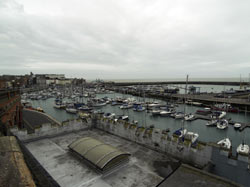Olympus 11-22mm f/2.8-3.5 wide-angle zoom
This wide angle zoom from Olympus is an attempt to cover the main drawback of cropped sensor cameras, that of the loss of angle of view. Designed for the 4/3rds system that sports a 2x crop factor, we take a look to see if it goes far enough.
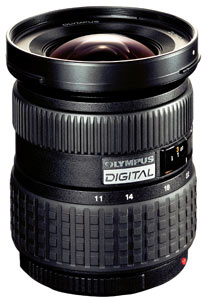 Specifications
Specifications
- Focal length 11-22mm
- Max aperture f/2.8-3.5
- Angle of view 89-53º
- Construction 12/10 elements/groups
- Min focus 0.28m
- Filter size 72mm
- Weight 0.485kg
- Dimensions 75x92.5mm
- Mount 4/3rds
- Lens hood LH-75 (supplied)
- SRP £599.99
Build and handling
A nicely put together lens that sports a 31mm zoom ring marked at 11,14,18 and 22mm which extends the lens by just 10mm when zoomed to the short end. Yes, this lens is the ‘wrong way round’ and is at it’s most compact at the longer focal length.
A distance window, marked in metres and feet separates the zoom ring from the ‘fly-by-wire’ manual focus ring, the switching of which is achieved through the camera menus.
The lens is well enough built for Olympus to claim ‘splash proofing’ although, not knowing how much ‘splash’ to apply, I refrained from testing this aspect!
A dedicated lens hood is supplied, although the one-niggly point about the lens was the inability, no matter how hard I tried, to remove the lens cap whilst the hood was in place. The front element stays in the same place during AF, which is reasonably quiet and quick enough, so use of filters causes no extra problems.
The angle of coverage is such that the P system from Cokin or its equivalent is just big enough to work without vignetting.
Optical quality
This lens is designed to overcome the loss of wide angle capabilities caused by the crop factor of the sensor, and in the case of the 4/3rds standard, this is a 2x crop. Therefore, the lens only equates to a 22-44mm in terms of the 135 format. As super wide angle lenses only enter that category once they go below the 20mm mark on 35mm film, this lens cannot really be called a super-wide and with a coverage of less than 90º at it’s widest, is a little disappointing in this respect.
Distortion is fairly well regulated, although barrel distortion is present throughout the focal length range. Figures of 0.34% were recorded at the 22mm end and this is negligible but by the time the 11mm end is reached these have increased to –2.64% and is detectable with the mark 1 eyeball past the +/-1.5% mark.
The lens is fitted with two aspherical elements to help control aberrations and the two rear elements have special coatings to help reduce flare and ghosting. Overall, these have been fairly successful, with no chromatic aberrations visible to the eye at 100%, even in the high contrast areas.
With a wide-open aperture of f/2.8 at the wide end, dropping to f/3.5 at the longer focal length, it is a fairly ‘quick’ lens for a zoom. However, as with most zoom lenses, it requires a little stopping down to achieve the best results and f/5.6 seems to give the optimum throughout the range. Unlike most of it’s ilk though, this lens has its best performance set in the middle of the range, at 16mm with the worst performance at the short end, an unusual phenomenon.
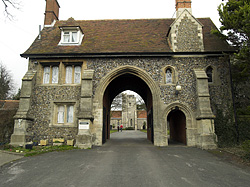 At 14mm, the lens is still wide enough to cause perspective distortion, which can be easily cured in software. 1/160sec at f/5.6 and ISO 100. | 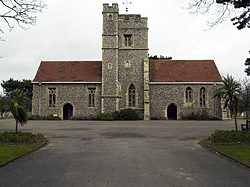 At 16mm and a better angle the lens gives a fair rendition of this Norman Chapel. f/5.6 and 1/200sec at ISO 100. |
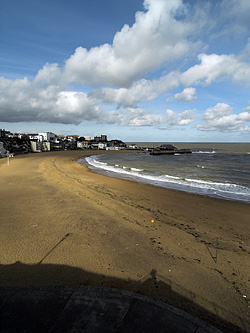 Although 11mm seems wide, on the 4/3rds system cameras it equates to 22mm with the 2x crop. f/8 at 1/1000sec and ISO200. | 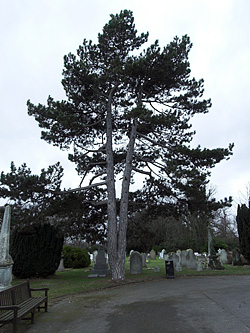 Despite the tree being silhouetted against a bland sky there were no visible chromatic abberation artefacts. 1/200sec at f/5.6 and ISO 100. |
Click on each comparision photo below to view full size versions
Below is our lens test data. To find out how to use these graphs look at this article: How we test lenses
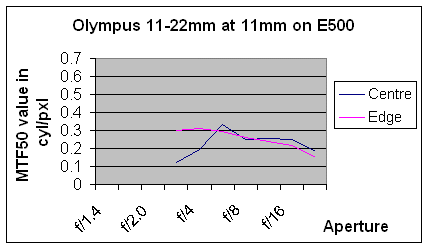
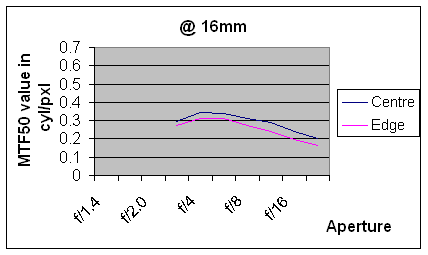
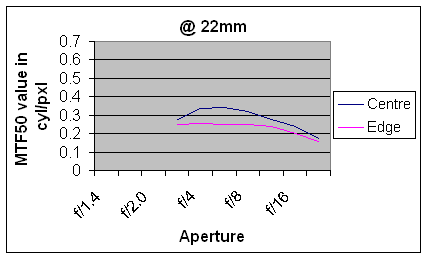
Verdict
The lens is a nicely put together piece of kit with a semi-pro spec and price to match. It sits nicely on the camera (I used an Olympus E-500). The disappointing aspect is the coverage, caused by the 2x crop factor of the 4/3rds system, leaving it a little lacking for dramatic landscapes and the like. I am not personally a fan of the ‘fly-by-wire’ manual focus system, although it does seem to work reasonably well. I can see the lens cap being lost quite easily as it is a pain to fit and remove with the hood fitted. If you are committed to 4/3rds, the best available at present.
In summary, the positive points of the Olympus 11-22mm f/2.8-3.5 are:
![]() Good build quality (Splash resistant)
Good build quality (Splash resistant)
![]() Good optical quality and control; of nasties.
Good optical quality and control; of nasties.
![]() Lens hood supplied
Lens hood supplied
The negative points are:
![]() Not really wide enough
Not really wide enough
![]() Electronic ‘manual’ focus
Electronic ‘manual’ focus
![]() Lens cap fiddly with hood fitted
Lens cap fiddly with hood fitted
Check the latest price of the Olympus 11-22mm f/2.8-3.5 here
Test by Ian Andrews www.wildaboutkent.co.uk
Add your message
Please login here or if you've not registered, you can register here. Registering is safe, quick and free.
photodo Stats
428 MTF tests
74 in-depth photodo reviews
100+ users join each day
Help the lens community by reviewing or rating a lens today via our lens search
Latest Lens Reviews
- Chinon 28mm f/2.8 Vintage Lens Review
- Canon EF 70-200mm f/4L IS II USM Lens Review
- Samyang AF 85mm f/1.4 EF Review
- Sigma 70mm f/2.8 DG Macro Art Review
- Samyang AF 24mm f/2.8 FE Review
- Meike 50mm f/1.7 Review
- Tamron 70-210mm f/4 Di VC USD Review
- Lensbaby Burnside 35mm f/2.8 Review
- Asahi Super Takumar 50mm f/1.4 Review
- Asahi Super-Multi-Coated Takumar 135mm f/3.5 Review
